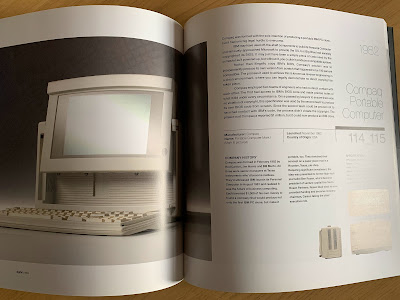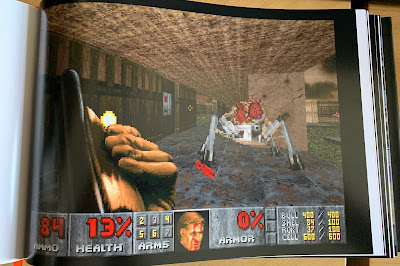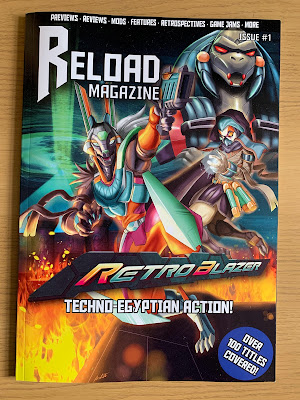Saturday, 25 February 2023
Speccy Nation by Dan Whitehead - Book Review
Saturday, 18 February 2023
I'm Too Young To Die by Stuart Maine - Book Review
Taking its title from the easiest difficulty option from DOOM, this chunky tome from Bitmap Books presents itself as the ultimate guide to first person shooters between the years 1992 and 2002. A lofty claim, given the nature of the subject, but one that, from initial impressions, could be highly accurate.
If you've purchased a Bitmap Books publication before, you'll know what to expect with regards to the quality. Extremely well packaged, the hardback is suitably sturdy and the paper stock used is perfect for imagery and text alike. There's a handy bookmark attached and if there is one criticism, it's the actual format. I get why but it doesn't half stick out on the bookshelf!
That quibble aside, what we get is a wander through the history of the first-person shooter. There is a brief introduction to the pre-1992 era before you get to the core of the book: a year by year run down of famous (and not so famous) shooters that graced pretty much every system you could buy in the shops.
It is this coverage that makes I'm Too Young To Die such a brilliant book. Sure, you get Wolfenstein, DOOM and Half Life, all of the usual suspects, but it's the coverage of the lesser known titles, the ones that maybe weren't critical or commercial hits, that lift this book to the heights of must buy.
For example, Blake Stone is an absolute classic, but due to its release coming just as DOOM redefined the genre, it died a death in the market. Here, it gets a loving write up. Each entry varies in size: quarter, half or full pages get a half page, and the format of the tome allows the screenshots to shine, whether they be 1/16th, a quarter or a full page in size. Having covered 3DO FPS's for RVG and Fusion magazine, it was great to see several included here, even if he does prefer the PC version of Escape From Monster Manor. And no mention of the sublime song that plays over the credits! Tsk! ;-)
As I progressed through this book, I found I was making a list of titles that I had never played the first time round and that appealed now. Sure, some have issues, and inclusion into this collection is a sign of how noteworthy the game was, not that it was actually a good title to play - Trespasser being a prime example. It turned out to be quite a list, as there are hundreds of games featured, yet it is a credit to the author that his writing style is as fresh with the last entry as it is with the first. As for the jokes, well, there are some doozies included, page 314 featuring a gag that, well... yes...
It's not just about the games though, as there are interviews with key contributors to the genre, including Ken Levine, David Doak, John Romeo and Warren Spector amongst others. Each of these is packed with detail and have something of interest even though many have been interviewed many, many times before. In a cute nod, they have DOOM-style portraits included at the beginning and end of the book and, it has to be said, they seem to have suffered in the interim, aside from Mr Romero, naturally.
As you can guess, this volume is very much worth your time if the FPS genre is a go to for you and this single volume on the topic can't be beaten. I not only have a reference for future years on my bookshelf, but also a long list of shooters that, one day, I'll eventually get to the bottom of. It would be really cool to see a follow up, charting how the genre moved on from 2003 onwards - from the commercial juggernauts of the Battlefield and Call of Duty series, the more interesting narrative shooters (Clive Barker's Jericho, Singularity, the Bad Company duo), to the complete and utter mess that was Rogue Warrior: all deserve their time in the sun.Well, apart from maybe Rogue Warrior, but anyhoo... For now though, pick up a copy of this fine book and revel in the rich and illustrious history of this evergreen genre.
You can buy I'm Too Young To Die directly from Bitmap Books, and can follow the author on Twitter here.
Saturday, 11 February 2023
Digital Retro by Gordon Laing - Book Review
There are times when you pick up a book and you know it's a keeper, even before you realise you're going to build up a library on a particular subject. Chandler's The Campaigns of Napoleon is one, Massie's sublime Dreadnought (and it's worthy follow up, Castles of Steel) are two more. For computing, it has to be this coffee table wonder: Digital Retro.
Written by former editor of Personal Computer World (RIP, you marvellous beauty of a magazine!) Gordon Laing, this is a book focusing on (mostly) affordable hardware that defined computing between 1975 and 1989 in the UK. With 192 pages, 400 pictures and in full colour, Digital Retro was one of the first retro-inspired books I ever saw in the wild back when it was published in 2004.
There is a short introduction and a brief history of computers before it kicks off with the first entry proper: the MITS Altair 8800. This establishes the formula for each machine. There's a large format photograph, background to the machine's creation, a company background, side areas for technical specifications, and a run down of name, manufacturer, year of release and country of origin. There are also sections on what happened next (and in some cases, these are tales of tragedy - looking at you, Osborne 1), as well as a "did you know" and many, many photographs of the kit from various angles.
 |
| As far as wish lists go, it's a doozy! |
Indeed, as every device gets four pages, it's the photography that gives this tome its true value. Oh, the text is well written and informative, but this is a book you look at first, and then read. And it's not just about computers, as games consoles such as the Coleco Vision, Nintendo Famicom/NES and the Sega Master System get a look in too. Each machine looks glorious and tugs at the part of my brain that says "you need to own one of these!" Then sense arrives and I don't even bother looking at modern day prices. But, by God, don't some of these machines look fantastic!
 |
| The Compaq Portable III. Hubba hubba!. |
The last entry is the NeXT Cube, and whilst it's great to see the likes of the Amstrad PCW and Acorn's Archimedes included along the way, there is the hint that a couple more systems could have been included. There again, the intro does state that coverage is aimed at mostly affordable home computers, with key business machines and games machines included where they have "influenced future standards", so these are the ones that made their mark (however lightly) on the market. And yes, some of the entries here tread very lightly in the UK - the Mattel Aquarius, Apple Lisa and Jupiter Ace were certainly available, but they failed to take off for a variety of reasons.
 |
| This was not the dawning of the Age of Aquarius. |
Finally, there is a post-history section, four pages taking us from 1989 to the then-present day. It all feels rather quaint, but then when it comes to technology, it often does. However, the author isn't wrong when focusing on three core technologies: broadband, wireless connectivity and seamless interaction without technical intervention - and it took a while, but the modern day smartphone epitomises those three technologies perfectly.
 |
| What style! What grace! What poise! |
Digital Retro is a glorious celebration of retro computing and a tremendous volume that acts as a love letter to the many (mostly incompatible) machines that the average 1980's buyer might have seen. It's a book I will never get rid of. Sadly, it is no longer in print and copies of Amazon are, to put it mildly, in the "collector's realm" of pricing. Or, as we say locally, "You want how much? Haddaway and shite, man!" If you can find a copy that doesn't cost the earth, grab it, and revel in peak 1970's and 80's computing. They just don't make them like they used to.
Saturday, 4 February 2023
Reload Magazine - Issue 1 review
Another new independent magazine arrives after a successful Kickstarter campaign last year, one that focuses on the genre of first person shooters, this time narrowing in on the indie developer scene. This 100 page (including covers) full cover magazine certainly looks the business and, given the pedigree of the writing team - some names will be familiar to readers of E1M1 magazine, Reload magazine promises much. Does it deliver?
As far as physical quality goes, yes. Yes, it does. The stock isn't glossy so there isn't the sheen that some people might like (although it made the pictures for this post so much easier to take!) but shiny isn't everything and the paper quality is more than good enough. It feels nice and doesn't smudge either.
Of course, content is key and this is where the selection of writers shines through. The magazine is split into several sections: Previews, Reviews, Mods, Features, Retrospectives, Game Jams, How to Guides, Developer Zone and Early Access. Whether it be a first look at a forthcoming release, checking up the latest indie efforts or features on a particular studio, the love for the topic is evident, and it's clear that the people writing about these games are passionate about the genre.
Indeed, it is this focus that makes Reload Magazine such a fantastic read and, after spending a couple of weeks working my way through it (I'll explain in a bit), the sheer number of titles in the indie first person shooter dev space is extraordinary. I know I shall be checking out more than a few of the 100 plus games mentioned in issue one as and when I have time, and I wouldn't have known about them without the benefit of reading this mag.
This brings me to screenshots - there are tons of them! The screens show off the diversity of the genre and whilst some of the games look a little "rustic" (been watching too many old-school Bake Off episodes in my youth), they're just icing on the top of a huge FPS cake. And besides, every aesthetic has its charm and the likes of Operation Pinkeye nails it's particular look perfectly. Between the text and the imagery, there is little wasted space (always good to see) and the few adverts that are present don't affect the content balance at all.
Reload Magazine is not perfect, though, but this is purely a personal thing and no reflection on the magazine or its team. However, if you are (unfortunately) like me, you need to know this. I said it took me a couple of weeks to get through this issue, a combination of savouring the writing but also dealing with a design choice which ended up being quite painful. White writing on a black background. This is purely a personal thing - my good lady had no problems at all - and although she liked the magazine, playing FPSs makes her go vom-vom. Nor did the couple of others who I showed my copy to. I found that reading three or four pages at a time was about the right pace. Would I still buy issue 2? Hell yes!
Regular blog readers will know that I am a massive fan of small scale independent publications, titles that cater to an audience that would never warrant a newsagent mag. Reload Magazine is a new entry and one that, if you are a fan of first person shooters, you need to check out, not only for the in-depth articles and reviews, but also for the insight you'll get into the very healthy and active indie developer scene. I know I'll be back to support issue 2! As always with print magazines, if it's one you like, support it however you can. With the recent demise of the print versions of Wireframe and Custom PC, the emphasis falls further on the small scale publisher industry and their esoteric wares.
You can also follow the magazine on Twitter here to keep up with all of their latest news and developments, and they have a website here as well. There should be news shortly about how non-Kickstarter backers can get hold of a copy as well as info on the next issue. I am sure they'll not be quiet about that!














